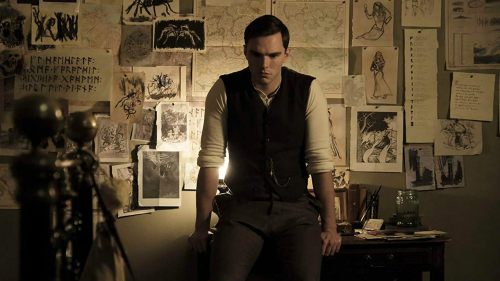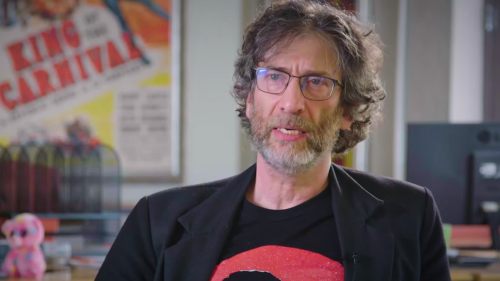Talking TOLKIEN With Dome Karukoski
You may not be overly familiar with the works of Dome Karukoski, but seven films since 2006 have brought him huge critical acclaim and box office success in his native Finland, leading to Variety naming him among their 10 Directors To Watch in 2013.
Karukoski’s films tell stories about apostasies of the religiously devout and the neo-Nazi, sexual awakenings of teenage girls and closeted gay men, and the trials of characters old, young, dumb and wise. Each is intimate and human, filled with rounded characters and shot through with distinctive personality and confident, unshowy technique which strikes a fine balance between drama, humour and not a little action. He’s also a colossal J.R.R. Tolkien fan, openly drawing parallels between their childhoods while noting how the author’s study of Finnish language and mythology fed into the high fantasy sagas which spawned an industry.
Tolkien almost feels tailor-made for Karukoski as it explores Tolkien’s youth and formative experiences before he wrote even a word of his most famous works. We sat down to discuss the movie in the context of his filmography and personal history with Tolkien, the challenges of shooting the film, and what the future might hold for this passionate, intelligent and voluble filmmaker.
This is almost a dream project for you, was it something you went out and pursued?
I’d just finished Tom Of Finland and when I got this script it hadn’t been released yet. I had met Fox Searchlight because of another idea we were discussing, and I had thoughts of doing something totally different right after a biopic, so I was prepared to say no, no I don’t want to do another biopic!
But the script changed your mind?
Because I’m a Tolkien fan I was always seeing C.S. Lewis in the Eagle And Child [pub in Oxford] smoking a pipe, drinking a pint and they’re debating elves. That’s my vision of Tolkien, so when I opened the script the revelation was that this is actually a cinematic, epic story: the story of the youth and the inspiration… well, now, okay, it’s not a biopic. It feels like this is a great, beautiful story to make, and that’s why you want to make the film.
Yet it feels like a part of a career progression in which each of your films build on the last by adding a bigger scope, more complexity and now big name actors. Is that part of a plan?
I don’t have a strategical plan, in that sense, what to do next. The only film I ever made that was part of a plan was Lapland Odyssey, my fourth film, because I’d made three dramas before that, award-winning dramas that toured around from the Berlinale to Karlovy Vary film festivals, and with [writing partner Aleksi Bardy], we just wanted to do something really goofy that just liberates us from this dark path of an artist. That was the only film coming not from the story, but from the idea of the kind of film I want to do next.
Yet Lapland Odyssey still ties back to Tolkien in a way because it’s a fantasy quest at heart, with a digital TV box as its One Ring.
Yes, and it’s an outsider story. It was a film journalist’s revelation that all my films are about outsiders, which is true because I was an outsider, like Tolkien: I was born in Cyprus and moved at the age of four and a half to Finland and I was bullied. At that time I was growing up without the father that I later grew to know, so I was always feeling like an outsider. Every story I’ve ever had has been some story of a misplaced person trying to find belonging.
And throughout your films, these outsiders assemble a surrogate family around themselves.
Exactly, they assemble a family and they find a place and a feeling of belonging and that’s what’s essential about this story. It’s an emotion I related to very strongly about Tolkien’s own life. I remember that phase when I didn’t have a father, I met him at the age of fourteen and we became friends closely in my late teens: you grow a very special bond with your mother and I can’t imagine if I would have lost my mother, who was the spine of my life at that time, because I didn’t really have friends. But like Tolkien, you feel like you have to move again, you have to find new friends and I know exactly that emotion, how maniacally important it was for him to find his friends, and then if you look at his life story he would form all these different clubs: the need to belong, having a family was so strong. So that was one of the main motives to choose to do this film: then you go off to war with these people who have become your family, and destroy your belonging, destroy what you had. That was an emotion I wanted to experience myself, through this film.
The film takes great pains to build up that family, even in the smaller parts like the amazing performance from Derek Jacobi. Is it intimidating to direct an actor of such stature?
I did The Grump with the Finnish legend Antti Litja and you forget very quickly that the first time these older actors arrive, on set there’s a starstruck feeling in you because you’ve watched their films and TV shows as a child. Then Derek Jacobi’s over there and, okay, so I’ve got to put aside my starstruck and respect of this older gentleman. I never expected an actor to find the perfect timing without any rehearsals. He asks “What’s the tone?” and I explain, “Professor Wright was very goofy, he was very playful and he was kind of a mentor. Tolkien and Professor Wright actually hit it off because they were very similar, they would speak weird languages,” and he’s just, “Okay” and he comes out of those hundred movies, he reads his script and he just comes in with it.
Obviously a lot more preparation goes into the realistic recreation of the Somme battlefield with its flooded trenches, explosions and scores of extras, but then it looks like it was really fun to shoot…
It was awful to shoot! It was horrendous, we were shooting up North in England and we talked about getting rain machines but luckily in northern England you don’t need them! We had built this World War I setting and when we went with the production designer to test it, good, great, people can run, they can move. Weekend comes, rain comes and by the time we arrived there was this amount [Dome holds his hand a foot or so from the floor] of mud and it was just horrendous. Of course, it was fun to shoot in [the sense] that the World War I [scenes are Tolkien’s] dream, and there’s of course lines and hints there: “You’ve slept for a long time,” Lily says, and [in the sound design] we go to dream landscape. I always thought that this doesn’t need exactly to be real, so I’m not stating that this is the exact event but this is the emotional feeling that he had. If you dream it as an old man, how would he see or perceive war as a dream, as an emotion? That was fun, going into that. I’m not talking about the hallucinations itself, I’m talking about the emotion, the feeling and the scenes being very dreamlike. That was something that I would say that was one of the most fun parts of the movie.
You mention the hallucinations, which are the biggest visual effects scenes that you’ve dealt with so far in your career. Is creating these images a big transition compared to your earlier movies?
Yeah, in Finland you never have the resource to do that, so as a Tolkien fan it’s quite a privilege when a studio like Fox Searchlight leans on you, like “Hey, welcome, you’re a Tolkien fan, let’s do a movie together!” and I think you’re privileged in having a studio that really backs their directors and supports their directors and is probably one of the best places to work in the world as a director, so every time I got a crazy idea you have this machinery behind you: you find a storyboard artist and you can draw it with the storyboard artist and they have the wonderful One Of Us VFX company in London who have a huge amount of artists and you’re creating, allowed to create your vision of the world.
That vision’s also very specific to this film, what was your inspiration in bringing it to life?
I was privileged to read the books before the films, and then even more privileged that none of these elements are… he hasn’t written anything. He’s just sketching, projecting small images, processing slowly and his mind is finding his own imagination while he’s living. So I have to remember how I felt the first time I read the books. I didn’t see [Ralph Bakshi’s animated The Lord of the Rings] because it was impossible to get in Finland in a rural area which had one video rental store, and if the VHS wasn’t there the movie didn’t exist! So I have to remember that emotion and then take a step back: how did he go into this? Then you’re creating a layer and whatever he’s seeing has to be coming from his heart. So he feels something and that generates an emotion and that later on becomes a part of his mythology.
This depiction of the processes behind creativity and the act itself is something which recurs in your films, all the way back to your debut in Beauty & The Bastard and very obviously in Tom Of Finland, yet it’s notoriously difficult to make cinematic. Are you always looking for new ways to portray creativity?
Yes and no. What’s wonderful at the moment, we are living through a new renaissance of filmmaking with all the CGI and the camera techniques, so you’re able to do more, you’re able to be closer to your imagination as a filmmaker to depict creativity. How I depict my own imagination? When I read The Lord Of The Rings when I was 12 or 13 and started playing the Dungeons & Dragons boardgames and started creating stories, I’m now actually in a situation where I can create that feeling of my own story building.
Is there a story in particular you have in mind which depends on getting closer to that feeling?
There’s a story about a character I would love to do which is… similar but it needs an even more difficult, almost impossible approach. I don’t know if I can reach it with 3D, if I can reach it with some new technique, if I wait for 10 years before that technique is invented, or if I have to do the Kubrick and invent my own technique to be able to do it, but the answer is yes, there is a story in my mind which I would love to do but I don’t think it’s possible yet. It’s a layer, so you break the fourth wall, so the audience will be with you in the creation. Without revealing too much, I have to work on it…
This interview has been lightly edited for clarity.



